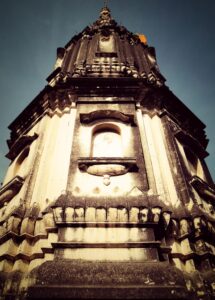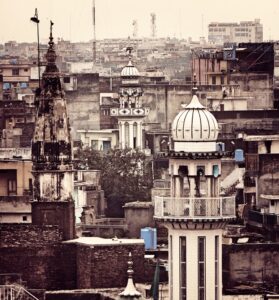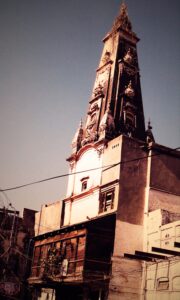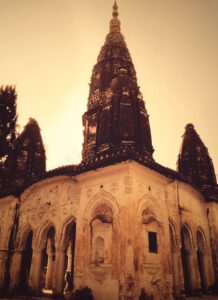Hidden among the narrow lanes of Rawalpindi’s old city, the Bagh Sardaran Mandir (also referred to in some sources as the Raghunath temple complex or Bagh-e-Sardaran) stands today as both an architectural landmark and a cautionary example of how communal heritage can be forgotten. Built in the late 19th century as part of a larger garden-haveli complex connected with Sujan Singh’s enterprises, the site originally housed multiple Hindu temples and Sikh gurdwaras and served as a focal point for inter-faith social life. Over the decades — and especially after the 1947 Partition — the complex has suffered neglect, encroachment, and functional repurposing.
Origins and design: a late-19th century communal complex
Local histories and archival references place the construction of the Bagh Sardaran complex in the 1890s (commonly cited dates are 1895–1897). According to historical summaries, the complex was created under the patronage of local Sikh leaders — including figures named in some records as Sardar Band Singh and Sardar Milkha Singh Thehpuria — and was deliberately conceived as a compound of temples, gurdwaras, gardens and welfare facilities. Contemporary descriptions describe domed spires, Mughal-influenced ornamentation and a layout that allowed the complex to function both as a religious centre and as a social-welfare node for the surrounding neighbourhood.
The complex’s proximity to Sujan Singh Haveli (the ornate mansion built by Rai Bahadur Sujan Singh in the early 1890s) reinforced the area’s identity as a multicultural precinct where Sikh, Hindu and Muslim households and institutions coexisted. Photographs from the pre-Partition decades show the temple spires and domes rising above the adjoining lanes, a visual reminder of the neighbourhood’s plural past.
Role in the community before Partition
Accounts from local researchers and heritage writers indicate that Bagh Sardaran was more than a ritual site: it acted as a welfare centre where free food and charity were distributed, and the wider grounds reportedly included gardens, a public pool, servant quarters and communal spaces that served residents of different faiths. The area once extended over several acres and formed a notable part of Rawalpindi’s civic life in the decades before 1947.
Partition, decline and encroachment
The mass migrations and violence of the 1947 Partition dramatically altered Rawalpindi’s demography. Many Hindu and Sikh families left for India; their places of worship and associated properties were left with far fewer caretakers. Over succeeding decades the Bagh Sardaran complex lost much of its original footprint to private allotments, informal encroachments and adaptive reuse. Reports from Pakistani press and heritage commentators say the original six-acre estate has been reduced to a few marlas in places, and parts of the complex have been converted into offices or residences (some agencies report Special Branch use of buildings), storage, or small commercial units.
News coverage and field reporting over the last decade have documented the physical decay: faded frescoes, broken plaster, leaking roofs and blocked passageways. While the skeletal domes and spires remain visually striking from nearby rooftops (including views from Sujan Singh Haveli), the structure’s interiors and courtyards bear the marks of long neglect. Heritage writers say the very scale of urban pressure in the old city — rising population density, informal construction and resource constraints — complicates conservation efforts.
Preservation efforts and official status
The fate of Bagh Sardaran has periodically surfaced in local media and civil-society campaigns. Journalists and heritage activists have urged provincial authorities to register and restore the complex under existing preservation laws, and to recognize these places as part of Pakistan’s plural cultural patrimony. Government agencies and the Evacuee Trust Property Board are sometimes referenced in reporting as custodians of former non-Muslim properties, but concrete, sustained restoration work for Bagh Sardaran has been limited and slow — a pattern seen at other pre-Partition religious sites across the region.
Several news pieces and photo essays (and the Wikipedia summary that aggregates them) suggest the complex is still visited occasionally by heritage researchers, photographers and, during Sikh and Hindu festivals, by diaspora visitors who travel to commemorate their historic places. Nonetheless, activists argue that legal protection, funding, and a systematic conservation plan are required to prevent further loss.
Why Bagh Sardaran matters
The story of Bagh Sardaran is not only an architectural or archaeological one — it is also a narrative about shared urban memory, coexistence and the way cities retain traces of plural pasts. The compound’s original purpose — a multi-faith complex with religious, social and charitable functions — speaks to a civic model that contemporary heritage advocates say is worth remembering. Preserving Bagh Sardaran, they add, would preserve an important chapter of Rawalpindi’s social history and provide a physical space where current and future citizens can engage with the city’s layered identity.










